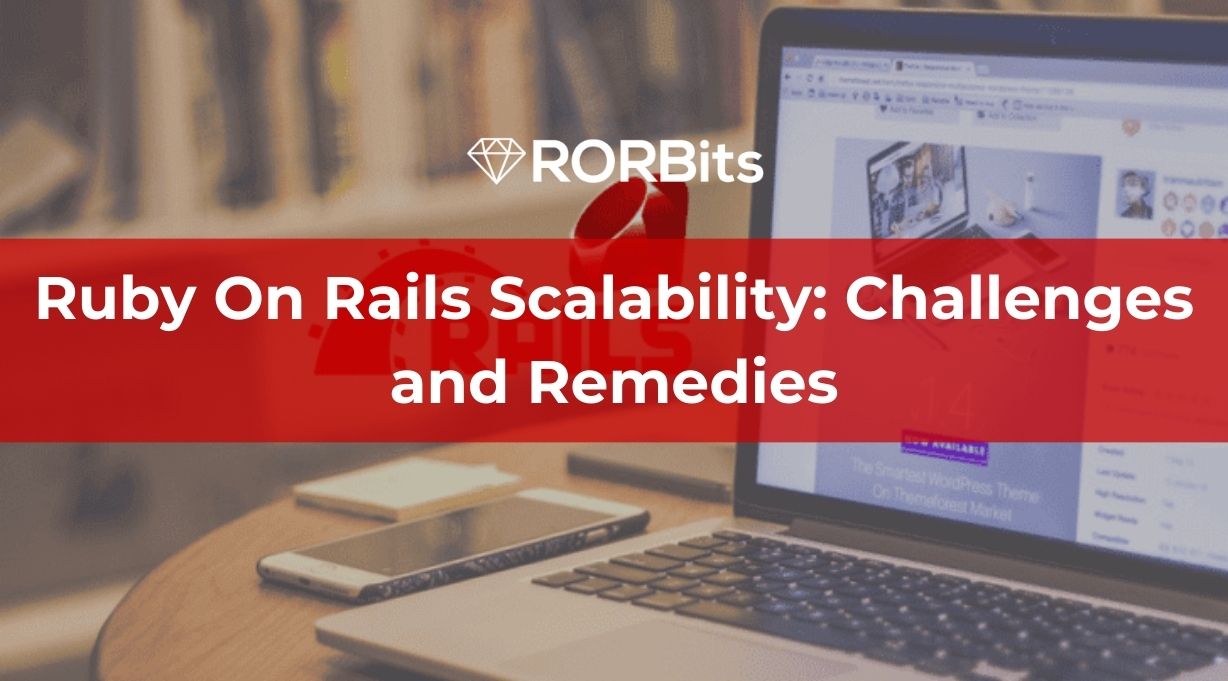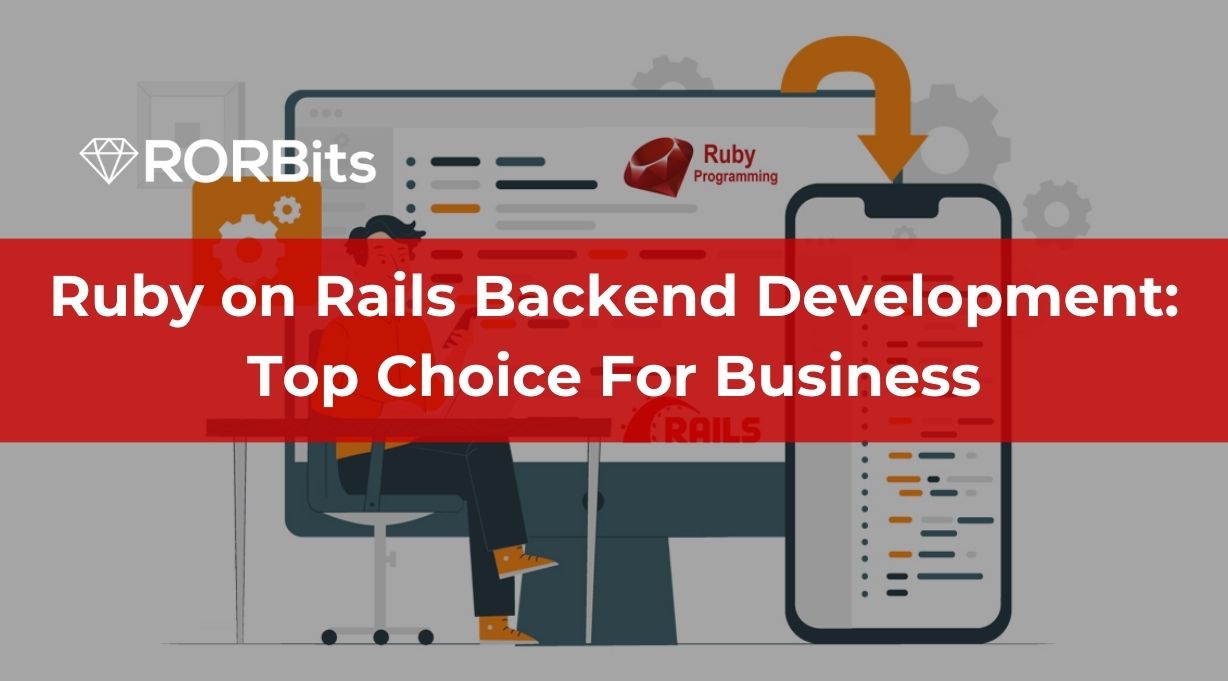If you really wonder which one is best between Ruby on Rails vs Laravel, then we want to choose Ruby on Rails.
But, you don’t have to decide it so quickly for your project! You can go through this article to compare Ruby on Rails vs Laravel on the basis of architecture, design, ease of use, scalability, performance, testing capacity, and so on.
We have discussed the important comparable points on the basis of practical facts. So you will get a clear idea for both the framework and you can easily decide which one is most suitable to your project!
Let’s Start!!
What Is Ruby on Rails?
Ruby on Rails is a famous framework based on Rails and written in the Ruby programming language.
David Heinemeier Hansson developed ROR and released it as an open-source project in July 2004.
This framework is based on Model-View-Controller (MVC) architecture.
Most developers love Ruby on Rails because it provides the metaprogramming feature in coding.
Developers employ XML and JSON to facilitate data exchange in support of Ruby on Rails.
Ruby on Rails reduces the development time that helps developers to focus more on the latest features for the web application.
ROR comes with the built-in static compilation tool that gives better performance for web app development.
Due to easy, reliable, and secure features of the Ruby on Rails makes Laravel vs Ruby as the most trending topic of consideration and discussion. And, we hope this blog will help you enough to decide which framework is best for your project.
You must work with ruby on rails development service for successful completion of ROR web development project.
What Is Laravel?
Laravel is also a web framework built in PHP.
Developers can use Laravel for web app development with MVC pattern. Laravel is one of the efficient web development frameworks which can help developers to build an app quickly.
Like Ruby on Rails, Laravel is also an open-source framework based on PHP.
Most developers choose Laravel for the feature of adding multiple plugins of various types in it.
Laravel can reuse the different components of an already existing web framework to help build a web app. Which gives a more structured and pragmatic web application design.
It consists of a rich set of features to speed up web development. To make your tasks easier with Laravel, then you should learn core PHP and advanced PHP.
Let’s make a quick comparison table for Ruby on Rails vs Laravel to learn basic differences between them.
Ruby on Rails vs Laravel: Quick Comparison Table
| Ruby on Rails | Laravel | |
| Language | ROR is based on the Ruby programming language. | Laravel is written in the PHP programming language. |
| Founded By | It was invented by David Heinemeier. | It was invented by Taylor Otwell. |
| Framework type | Used in development of web framework. | Used in development of web framework. |
| Launched Year | Ruby on Rails was released in July, 2004. | Laravel was released in June, 2011. |
| Syntax | ROR doesn’t provide any kind of support for semicolons and curly braces. | Semicolons and Curly Braces are used by Laravel. |
| Latest Version | Rails 7.0.4 | Laravel 10 |
| License | ROR operates under MIT license. | Laravel operates under MIT license. |
| Usage | Database-backed web applications are developed with ROR and it supports metaprogramming also. | Enterprise-level applications and small businesses websites are built with Laravel. |
| Community | Railcasts is the popular Ruby on Rails community. | The Laravel community is growing day by day and is known as Laracasts. |
| Template Engine | ERB is the default template engine which is used by Ruby on Rails. | Template engine is used by Laravel, known as Blade. |
| ORM (Object Relational Mapper) | ActiveRecord is used by the Ruby on Rails framework as the Object Relational Mapper (ORM). | Eloquent is used by Laravel framework as the Object Relational Mapper (ORM). |
| Features | Ruby provides a wide range of features such as third party plugins, ruby with clear syntax, and good MVC support. | Fast ORM, own CLI, authentication capabilities are the famous features offered by Laravel. |
| Scalability | Ruby on Rails is not preferred as the first choice for scalability options. | Laravel is adaptable and better for executing code. |
| Learning Curve | Ruby on Rails has a smooth learning curve and that makes it an easy framework to learn. | Steep learning curve is preferred by Laravel, that means it’s not an easy framework to learn. |
| MVC Architecture | Yes, Ruby on Rails follows Model-View-Controller (MVC) architecture. | Yes, Laravel follows Model-View-Controller (MVC) architecture. |
| Database Support | Ruby on Rails is supported by PostgreSQL, MySQL, SQLite, SQL Server, Oracle, and more. | Laravel is supported by MySQL, PostgreSQL, SQLite, SQL Server. |
| Routing | ROR supports RESTful Routing. | Laravel supports RESTful Routing. |
| Testing | Ruby on Rails has Built-in testing framework (Minitest). | Laravel has Built-in testing framework (PHPUnit). |
| Tools Availability | Ruby Gems | Plugins, Tools |
| Popular Companies | Etsy, Shopify, Github are the popular examples of Ruby on Rails framework. | 9GAG, BBC, TourRadar are some famous examples of Laravel framework. |
Let’s compare Laravel vs Ruby on Rails in different aspects.
Ruby on Rails VS Laravel: Architecture And Design
Ruby on Rails and Laravel both are the most popular frameworks and highly used for web development.
Both frameworks follow the Model-View-Controller (MVC) architecture pattern, but the difference sets in design approach and coding conventions.
Architecture And Design of Ruby On Rails
Ruby on Rails follows a “Convention Over Configuration” (COC) principle that emphasizes standardization and consistency in project structure and coding conventions.
ROR consists of three major components in its architecture.
1. Model
2. View
3. Controller
All these components of ROR architecture are responsible for data management, rendering views, and handling of user requests, respectively.
Let’s dive into the each individual component:
1. Model
In Ruby on Rails, The role of Model is to manage data and interaction with databases. To define a structure and behaviour of the representing data, each model is corresponding with tables in the database.
ROR provides several built-in tools and conventions to streamline and simplify the procedure of working with models including ActiveRecord-The powerful ORM (Object-Relational-Mapping) tool which allows developers to do interaction with the database by using code of Ruby programming language.
For instance, Here’s an example of a simple Ruby on Rails model definition:
class User < ApplicationRecord
validates :email, presence: true, uniqueness: true
end
In this illustration, we construct a User model that maps to a database table called users. We also provide validation to make sure the email field is legitimate and present.
2. View
To render the user interface in Ruby on Rails, View is responsible for it.
Programmers typically construct views in HTML with seamlessly integrated Ruby code (using the ERB syntax), allowing for dynamic HTML generation based on model data.
Here’s a straightforward view that shows a list of users as an illustration:
<h1>Users</h1>
<ul>
<% @users.each do |user| %>
<li><%= user.name %></li>
<% end %>
</ul>
In this illustration, we create a list of users using the @users instance variable (which is specified in the controller). Ruby code can be embedded (%%>) and printed (%=%>) using the ERB syntax.
3. Controller
Controller is the one who can handle user requests and coordinate between the model and the view in the Ruby on Rails.
Controllers commonly define Ruby classes, with each action associated with a specific URL route.
Here is an illustration of a straightforward controller with two defined actions: index, which shows a list of users, and show, which shows a single user:
class UsersController < ApplicationController
def index
@users = User.all
end
def show
@user = User.find(params[:id])
end
end
In this illustration, a list of all users is fetched using the User model in the index action, and a particular user is fetched using the show action. Instance variables (@users and @user) that can be accessed in the respective views are then set.
Now, if you are planning to start your project in ruby on rails, then you should contact ruby on rails consulting agency to get better information and supportive start.
Architecture And Design of Laravel
Like Ruby on Rails, Laravel adheres to the “convention over configuration” principle. But Laravel also uses more recent programming ideas like service providers and dependency injection.
Laravel adheres to the Model-View-Controller (MVC) architecture paradigm, just like Ruby on Rails.
To help create complicated apps simpler, Laravel also contains a number of other design patterns and conventions.
Let’s examine some of the main elements of the Laravel architecture in more detail:
1. Model
Similar to Ruby on Rails, the model in Laravel is in charge of handling data management and connecting with the database.
To make working with models simpler, Laravel also applies a number of additional design patterns and conventions.
For instance, Eloquent, a potent ORM (Object-Relational Mapping) tool included with Laravel, enables developers to communicate with the database using PHP code.
Developers can save a ton of time and work by using Eloquent’s simple capabilities, which include automatic timestamping and soft deletes.
Here is an example of a straightforward Laravel Eloquent model definition:
<?php
namespace App\Models;
use Illuminate\Database\Eloquent\Model;
class User extends Model
{
protected $fillable = [‘name’, ’email’, ‘password’];
}
In this illustration, we construct a User model that maps to a database table called users. Using the $fillable attribute, we also specify the fields that can be assigned in bulk.
2. View
Like Ruby on Rails, Laravel views are in charge of rendering the user interface.
To make dealing with views simpler, Laravel also offers a variety of additional capabilities and conventions.
For instance, Laravel comes with a potent templating engine called Blade that enables developers to create templates with a clear, legible syntax.
Blade supports capabilities like conditionals, loops, and template inheritance, which can simplify the creation of intricate user interfaces.
Here is an illustration of a straightforward Laravel Blade template:
<h1>Users</h1>
<ul>
@foreach ($users as $user)
<li>{{ $user->name }}</li>
@endforeach
</ul>
This example creates HTML output by iterating through a list of users using the @foreach directive. In order to export data from the model, we also employ the {{ }}.
3. Controller
Like Ruby on Rails, Laravel uses controllers to manage user requests and coordinate communication between the model and the view.
To make using controllers simpler, Laravel also has a variety of additional features and conventions.
For instance, Laravel has an effective routing system that enables programmers to construct URL routes with a clear, legible syntax.
Middleware and dependency injection are just a couple of the additional technologies that Laravel offers that may make developing complex applications much simpler.
Here is an illustration of a straightforward Laravel controller:
<?php
namespace App\Http\Controllers;
use App\Models\User;
use Illuminate\Http\Request;
class UserController extends Controller
{
public function index()
{
$users = User::all();
return view(‘users.index’, compact(‘users’));
}
public function show($id)
{
$user = User::findOrFail($id);
return view(‘users.show’, compact(‘user’));
}
}
In this illustration, a list of all users is fetched using the User model in index action, and a particular user is fetched using the show action. Using the compact() function, we then feed the data to the necessary views.
Key Differences Between Laravel vs Ruby on Rails
Both Ruby on Rails and Laravel employ the Model-View-Controller (MVC) architecture paradigm, yet they exhibit variances in several substantial domains.
The following are some of the most notable variations:
Language
The most noticeable distinction stems from the programming language upon which they construct them.
Laravel uses PHP, a language known for its wide adoption and popularity in the web development community, while Ruby on Rails uses Ruby, a language renowned for its simplicity and elegance.
Community and Ecosystem
Both frameworks have vibrant communities and extensive ecosystems, but PHP’s ecosystem is generally larger due to its widespread use across the web.
Laravel has an active community and a growing number of packages, while Ruby on Rails has a mature ecosystem with a broad range of gems (Ruby libraries).
Syntax and Conventions
Due to the differences in their programming languages, the syntax and conventions in Laravel and Ruby on Rails vary significantly.
Ruby on Rails follows the principle of “Convention over Configuration,” meaning it provides sensible defaults and conventions, reducing the need for explicit configuration.
Laravel, on the other hand, has a more explicit syntax and configuration approach.
Migrations
Both frameworks offer migration systems to manage database schema changes.
The framework Laravel incorporates its migration system, while Ruby on Rails employs ActiveRecord migrations.
Database Interaction
Both Laravel and Ruby on Rails come with robust ORM (Object-Relational Mapping) features that let programmers communicate with databases. ActiveRecord, a potent ORM that lets developers carry out intricate database transactions using Ruby code, is a component of Ruby on Rails.
On the other hand, Laravel comes with Eloquent, a potent ORM that offers a variety of useful features including automatic timestamping and soft deletes.
Eloquent has a number of useful capabilities, such relationships and eager loading, that can make working with databases more simpler.
It also enables developers to do sophisticated database operations using PHP code.
Templating and Views
Both Ruby on Rails and Laravel incorporate robust templating engines that allow programmers to craft clear and understandable templates using a straightforward syntax.
ERB (Embedded Ruby), a component of Ruby on Rails, enables programmers to incorporate Ruby code into HTML templates.
On the other side, Laravel comes with Blade, a potent templating engine that enables developers to create clear, legible templates using a straightforward syntax.
Blade also has a variety of capabilities that can make creating complex user interfaces considerably simpler, like template inheritance and control hierarchies.
Routing and URL Handling
Both Ruby on Rails and Laravel have robust routing systems that empower programmers to craft URL routes using clear and legible syntax.
Developers can design routes using RESTful principles thanks to Ruby on Rails’ robust routing mechanism.
Contrarily, Laravel has a robust routing system that enables developers to design routes using a clear, legible syntax.
Laravel’s additional capabilities, like middleware and route model binding, can significantly simplify the process of working with routes and URLs.
Let’s find out the best one for your project;
Ruby on Rails vs Laravel: Which One Is Best For Your Project?
Famous web development frameworks Ruby on Rails and Laravel each have their own advantages and disadvantages.
The choice between the two depends on various factors related to your project’s requirements, your team’s expertise, and the overall goals of your application.
Let’s break down the key points for each framework to help you make an informed decision:
Project Requirements
Consider the specific requirements of your project. Both frameworks are capable of building a wide range of applications, but one might be more suitable for your project’s needs.
Developer Expertise
If your team is more comfortable with a particular programming language (Ruby or PHP), that might influence your decision.
Speed of Development
If you need to launch your application quickly, Rails’ convention-based approach might speed up the development process.
Community and Resources
Consider the availability of resources, plugins, and third-party libraries for each framework.
Scalability
Both frameworks can scale, but Laravel’s modular structure might provide more flexibility as your application grows.
Ultimately, there’s no definitive answer as to which framework is better; it depends on your unique project and team dynamics.
You should evaluate both frameworks based on your project’s requirements and your team’s expertise before deciding.
Final Words
In conclusion, the choice between Laravel and Ruby on Rails depends on factors such as the project requirements, the developer’s proficiency in the respective languages, and the development team’s preferences.
Both frameworks have proven to be effective tools for building robust and scalable web applications.
Still if you are looking for any specific suggestion, then you should go for Ruby on Rails, because ROR is easy to understand and builds robust and secure web apps with support of a large community.
Check out for the ruby on rails backend developer to start your new project with Rails framework!!
HAPPY ROR, HAPPY LARAVEL!!




